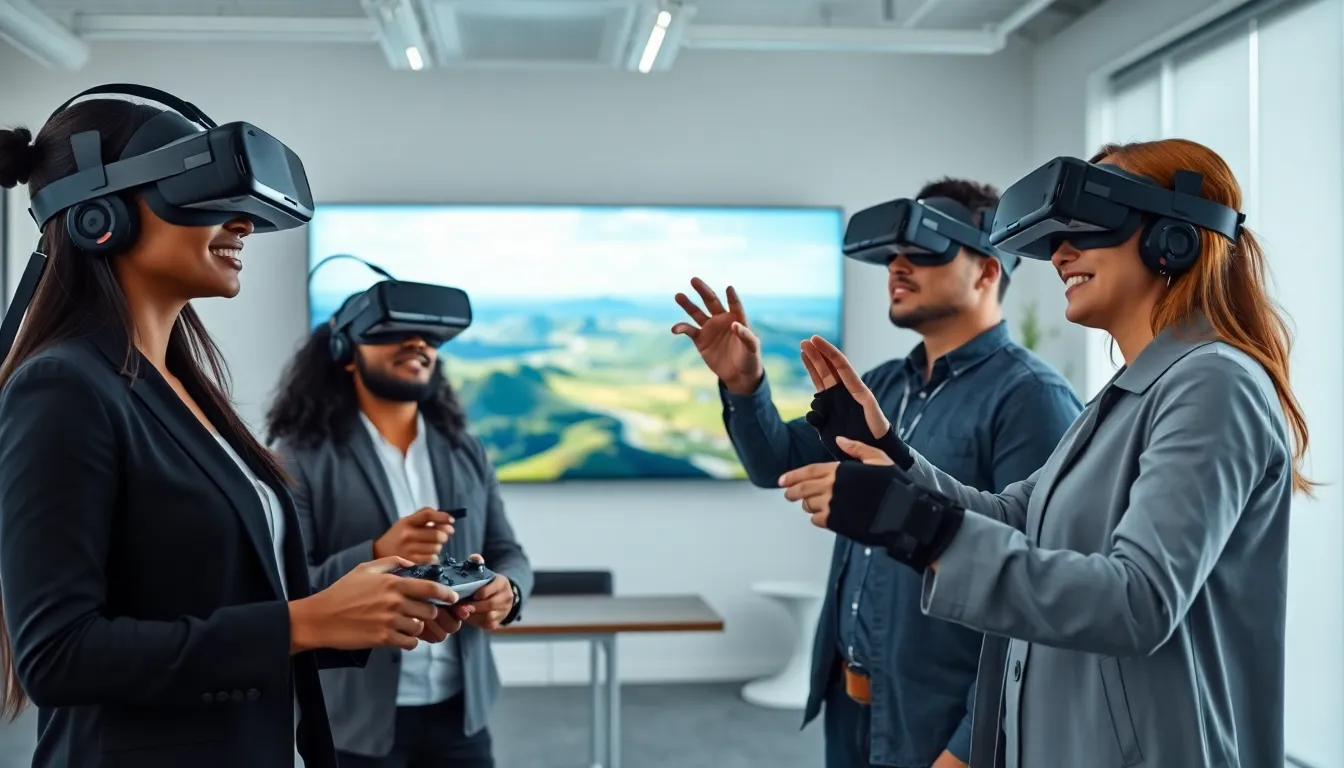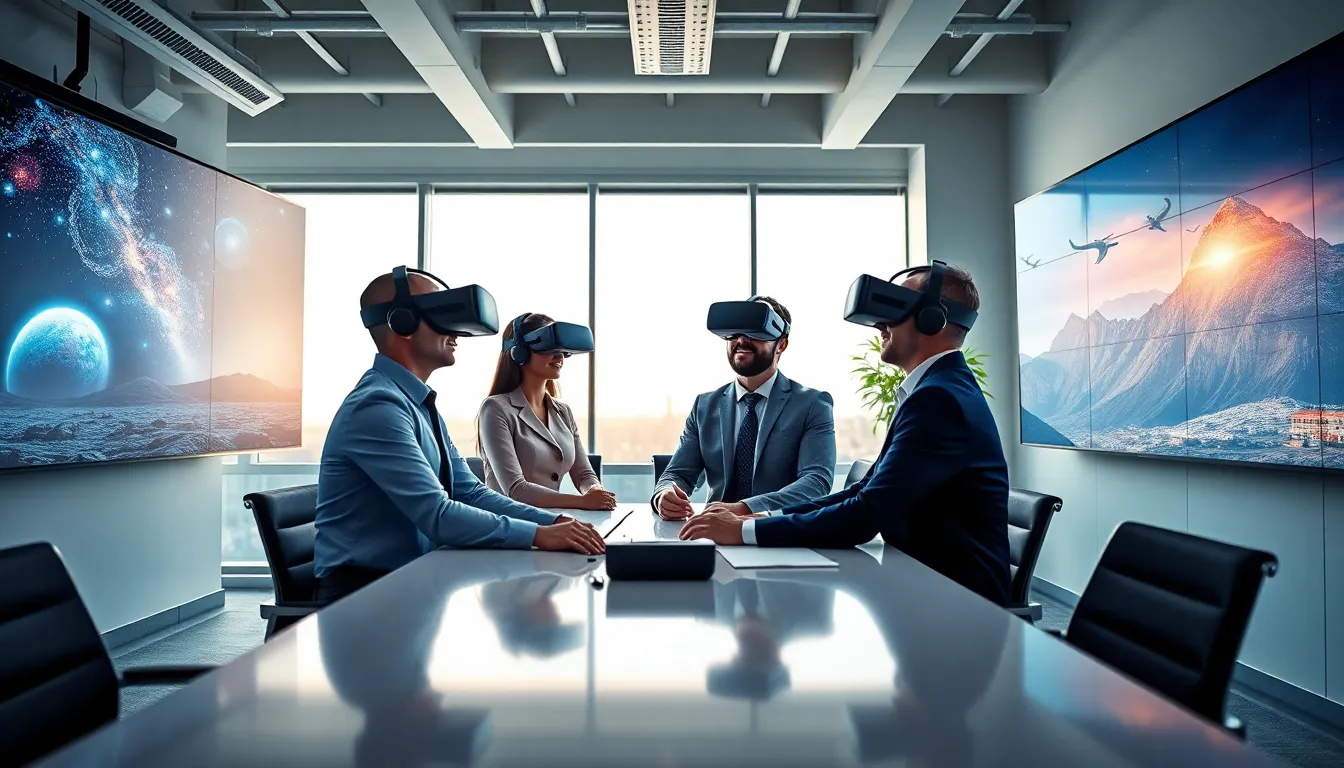Table of Contents
ToggleImagine stepping into a world where you can explore distant galaxies, practice surgery, or even walk through a luxurious mansion, without ever leaving your living room. Welcome to the fascinating array of virtual reality applications. In this digital playground, the boundaries of imagination and reality blur, creating immersive experiences that engage, educate, and entertain. If you think virtual reality is just for gamers, think again: the applications span industries and redefine how we interact with the world around us. Buckle up as we dive deeper into this thrilling tech.
Understanding Virtual Reality Technology

Key Components of Virtual Reality
To grasp how virtual reality (VR) works, one must first understand its essential components. At its core, the technology relies on hardware and software that create a simulated environment.
- Head-Mounted Displays (HMDs): These goggles or helmets wrap around the user’s head, displaying the virtual environment while blocking out the physical world. Popular devices like Oculus Rift and HTC Vive are perfect examples.
- Motion Tracking Sensors: They detect the user’s movements, translating them into the virtual space. This technology can range from optical sensors to accelerometers.
- Input Devices: Controllers, gloves, or even treadmills allow users to interact with virtual environments. These devices enhance immersion by enabling a natural experience, as movements are replicated in the digital world.
- Software: Advanced algorithms generate realistic graphics and environments. Powerful computing helps create seamless interactions, making the virtual experience as lifelike as possible.
Types of Virtual Reality Systems
Virtual reality can be classified into several categories:
- Non-Immersive VR: This form allows users to interact with 3D environments without the need for extensive hardware. Think of playing a VR game on a regular monitor, immersive but not completely isolating.
- Semi-Immersive VR: Offering a more engaging experience, semi-immersive setups often use large screens or projectors. An example is a flight simulator with a large display that mimics cockpit controls.
- Fully Immersive VR: This is where the magic happens. Fully immersive VR utilizes HMDs, motion tracking, and surround sound to transport users entirely into a new realm. Whether training for surgery or experiencing thrilling roller coasters, the vibes are insane.
- Collaborative VR: Users can interact with others in a shared virtual space, promoting teamwork. Imagine architects meeting in a digital version of a building to discuss design features, efficiency at its finest.
Applications Across Various Industries
Healthcare Innovations
In healthcare, virtual reality applications are nothing short of revolutionary. Medical students can practice surgical procedures in a risk-free environment, allowing them to build confidence and skills before they operate on real patients. Also, VR has been utilized for pain management, where patients undergoing painful procedures can immerse themselves in calming virtual landscapes, effectively tricking the mind into feeling more at ease.
Education and Training Simulations
Imagine a classroom where students can interact with historical figures, explore the depths of the ocean, or visit ancient civilizations, all from their desks. Educational institutions increasingly carry out VR to enhance learning experiences. Virtual field trips allow students to engage deeply with the material, ensuring concepts stick. Teachers can create simulations for complex subjects, transforming education into an awe-inspiring adventure.
Entertainment and Gaming Experiences
Gaming largely popularized virtual reality, transporting players into worlds where they can battle dragons or solve intricate puzzles. Today, immersive storytelling has reached new heights, with VR allowing developers to craft experiences that feel more real than ever. The thrill of skateboarding without the risk of injury? Sign me up. It’s a game-changer, quite literally.
Real Estate and Virtual Tours
In the real estate industry, virtual reality provides a significant advantage. Prospective buyers can take virtual tours of properties from the comfort of their homes. Real estate agents harness this technology to showcase homes in a captivating way without scheduling endless showings. This has notably improved the property search process, helping buyers make informed decisions faster.
Manufacturing and Design Visualization
Manufacturers and designers use VR for prototyping and visualizing products before creating physical versions. VR tools can simulate workflows and detect potential flaws early in the design phase, saving both time and money. Collaborative features allow teams to gather in virtual spaces to brainstorm, making it easier than ever to innovate.
Challenges and Limitations of Virtual Reality
Technical and Hardware Constraints
Even though the dazzling possibilities of VR, challenges remain. High-end hardware can be costly and often requires powerful computers to run the latest software. Users may find themselves needing a considerable investment, which can limit accessibility. Also, many VR experiences require space to move around safely, an obstacle in smaller living areas.
User Experience and Accessibility Issues
User experience is paramount in the adoption of any technology, and VR is no exception. Poorly designed interfaces or uncomfortable gear can result in motion sickness or fatigue. Besides, accessibility options for individuals with disabilities are still developing, which means that not everyone can equally enjoy virtual experiences. Enhancing accessibility must be a priority to fully harness VR’s potential.
Future Trends in Virtual Reality Applications
Emerging Technologies and Innovations
The future of virtual reality is bright and filled with potential. Innovations continue at a rapid pace, from improved graphic rendering to more sophisticated motion tracking. Developments in artificial intelligence are poised to enhance user interactions, allowing for incredibly realistic virtual companions and environments that respond dynamically to the user. This promises richer storytelling and educational experiences.
Predicted Growth and Market Trends
Market trends suggest that the VR industry will continue to expand exponentially. Industries such as gaming, education, and healthcare are projected to invest significantly in virtual reality solutions. Meanwhile, advancements in hardware are anticipated to become more affordable, enabling broader access across demographics. Brands recognizing the importance of VR in marketing and customer engagement strategies will likely seize this opportunity for growth.





